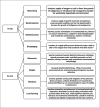Bioremediation Options for Heavy Metal Pollution
- PMID: 31893164
- PMCID: PMC6905138
- DOI: 10.5696/2156-9614-9.24.191203
Bioremediation Options for Heavy Metal Pollution
Abstract
Background: Rapid industrialization and anthropogenic activities such as the unmanaged use of agro-chemicals, fossil fuel burning and dumping of sewage sludge have caused soils and waterways to be severely contaminated with heavy metals. Heavy metals are non-biodegradable and persist in the environment. Hence, remediation is required to avoid heavy metal leaching or mobilization into environmental segments and to facilitate their extraction.
Objectives: The present work briefly outlines the environmental occurrence of heavy metals and strategies for using microorganisms for bioremediation processes as reported in the scientific literature.
Methods: Databases were searched from different libraries, including Google Scholar, Medline and Scopus. Observations across studies were then compared with the standards for discharge of environmental pollutants.
Discussion: Bioremediation employs microorganisms for removing heavy metals. Microorganisms have adopted different mechanisms for bioremediation. These mechanisms are unique in their specific requirements, advantages, and disadvantages, the success of which depends chiefly upon the kind of organisms and the contaminants involved in the process.
Conclusions: Heavy metal pollution creates environmental stress for human beings, plants, animals and other organisms. A complete understanding of the process and various alternatives for remediation at different steps is needed to ensure effective and economic processes.
Competing interests: The authors declare no competing financial interests.
Keywords: bioremediation; biosorption; contaminants; environment; heavy metals; microorganisms; organic matter.
© Pure Earth 2019.
Figures
References
-
- Wuana RA, Okieimen FE. Heavy metals in contaminated soils: a review of sources, chemistry, risks and best available strategies for remediation. Int Sch Res Notices. 2011;2011:20. doi: 10.5402/2011/402647. [cited 2019 Aug 21] Article 402647 [ p.]. Available from: - DOI
Publication types
LinkOut - more resources
Full Text Sources




